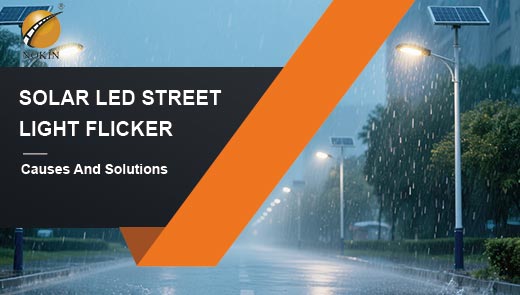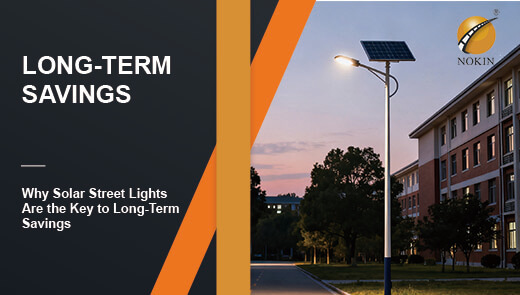A Complete Guide to Help You Become an Expert at Village Solar Street Light
While cities are illuminated by stable lighting at night, many rural areas still face the reality of “difficult lighting”—either relying on high-cost, high-pollution traditional energy sources or limiting the possibilities of life and production in darkness. This dilemma is not merely about the brightness of the night but also closely tied to rural ecological conservation, economic expenditure, and residents' quality of life.
The emergence of village-level solar street lights offers a systematic solution to this problem: they do not rely on the power grid or consume fuel, yet they can illuminate rural roads in a clean manner. This aligns with rural areas' demand for low-cost, low-maintenance solutions while also responding to the contemporary requirements of green development. This article will start by examining the core differences between solar street lights and traditional street lights, then delve into their selection logic and practical value, aiming to assist more rural regions in adopting this sustainable solution.
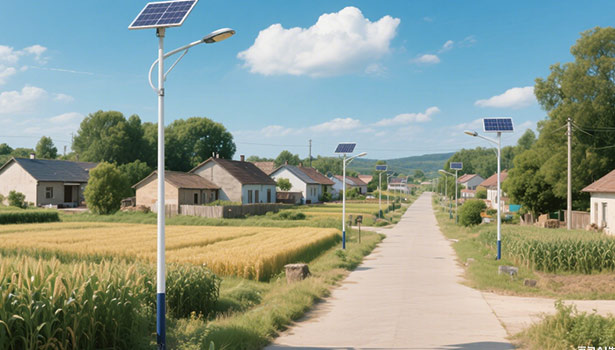
The Growing Need for Sustainable Energy in Rural Communities
Many rural and remote areas have long been plagued by energy supply issues. Villagers often rely on diesel generators or kerosene lamps for lighting, which have obvious drawbacks: diesel generators are expensive to fuel, increasing the burden on households and communities, and they emit smoke and noise, polluting the rural air; kerosene lamps provide dim light, strain the eyes, and pose a fire risk, especially for villages with thatched roofs or farmland.
This energy poverty limits rural development: dim lighting prevents children from studying at night and villagers from engaging in nighttime activities; high energy costs squeeze incomes; and long-term use of fossil fuels damages the rural ecosystem. Therefore, sustainable energy solutions such as solar street lights have become an urgent need for rural areas — solar energy is clean and renewable, requires no grid connection, and has no fuel costs, helping rural areas overcome their energy challenges.
Differences Between Solar and Typical Street Lights
Energy
In terms of energy, village-level solar street lights rely on solar power, which is a clean, renewable energy source that does not require additional energy costs. It converts sunlight directly into electricity through solar panels and stores it, with zero emissions throughout the process, fully aligning with rural areas' ecological protection needs. Traditional street lights, however, rely on grid power, which primarily comes from fossil fuels, whose combustion produces pollutants. Additionally, the transmission and distribution of grid electricity also consume energy, so traditional street lights not only incur ongoing electricity costs but also indirectly increase environmental burdens.
Cost
From a cost structure perspective, village-level solar street lights have relatively high initial investment costs, primarily involving the procurement of core components such as solar panels and batteries. However, there are no ongoing electricity costs, and the components are durable with low maintenance costs. For rural collective economies, long-term use can significantly reduce total expenditures. Traditional street lights have lower initial installation costs, but daily electricity costs are high, and the wiring and fixtures are prone to wear and tear, requiring frequent maintenance. As usage time increases, the aging of street lights further increases maintenance difficulty and costs, resulting in higher total expenses over the long term.
Voltage
In terms of voltage safety, village-level solar street lights use a low-voltage design of 12V or 24V. This low-voltage characteristic fundamentally reduces the likelihood of circuit overheating and significantly lowers the risk of electric shock, especially for children, making them highly suitable for rural environments with frequent human activity. Traditional street lights use high-voltage systems of 110V or 220V. Issues such as aging wiring and damaged insulation can lead to electrical leaks, and in rural outdoor environments with high dust levels, such safety hazards are particularly prominent, posing a threat to the daily safety of villagers.
Installation Difficulty
Solar street lights are independent systems that do not rely on the power grid, offering highly flexible installation locations and can be installed anytime, anywhere; traditional street lights must be connected to the power grid, and installation must adhere to grid configurations and relevant regulations set by power companies, subjecting them to numerous restrictions. In terms of installation difficulty, the installation of village-level solar street lights is extremely simple, requiring only the construction of a cement foundation and a battery pit, followed by securing the street light with bolts; the installation of traditional street lights, however, requires significant manpower and resources, with a more complex process.
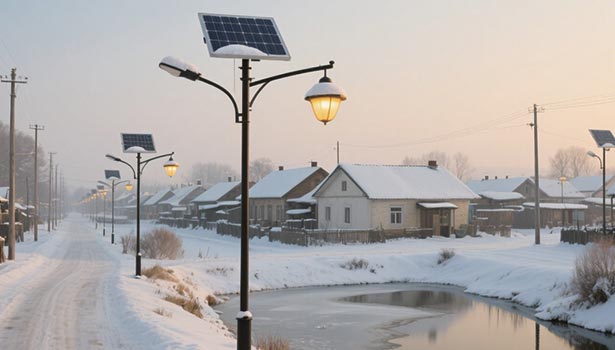
Brightness
In terms of brightness characteristics, traditional street lights are generally brighter than solar street lights, as they are directly connected to the grid, enabling stable and sufficient power supply, and can easily achieve high brightness output by increasing power. However, the brightness of solar street lights is not fixed. If higher brightness is required for rural roads, squares, or other scenarios, this can be achieved by installing larger solar panels and batteries — but this directly increases the initial procurement cost, as high-power components have higher manufacturing and material costs.
Additionally, once installed, the brightness of traditional street lights cannot be flexibly adjusted. Even during nighttime periods with low foot traffic, they must maintain a fixed brightness, which can lead to power waste. Solar street lights, however, can adjust brightness through a smart control system, such as automatically reducing power during late-night hours. This meets basic lighting needs while saving energy, offering flexibility that better aligns with rural areas' varying lighting requirements at different times.
How to Choose Village Solar Street Lights?
Light Pole Height
The selection of light pole height should be based on the width of rural roads. Most rural roads are 3-5 meters wide, with a pole height of 5-6 meters being most appropriate. If the pole is too tall (over 6 meters), the light will scatter, causing energy waste; if too short (under 5 meters), the lighting range will be insufficient to cover the entire road surface. Following the principle of “3-5 meter wide roads paired with 5-6 meter poles” achieves a balance between brightness and energy efficiency.
Light Source
When selecting light sources for rural areas, LED lights should be prioritized—they have a long lifespan and low energy consumption, making them well-suited to rural needs. Rural street lights are often installed outdoors, and replacing them is time-consuming and labor-intensive. LED lights typically have a lifespan of over 50,000 hours, reducing the hassle of frequent replacements. In terms of power, 40-60 watt LED lights are sufficient. Rural roads have relatively low pedestrian and vehicle traffic, so overly high-power lighting is unnecessary and would increase the burden on solar panels and batteries, leading to energy waste.
When selecting lights, note two key points: first, high luminous efficacy is essential. LED lights with high luminous efficacy can emit brighter light at the same power level, meeting lighting needs without excessive energy consumption; Second, low annual lumen depreciation is essential. Low lumen depreciation ensures the lights do not dim rapidly, maintaining stable illumination over the long term and reducing maintenance costs.
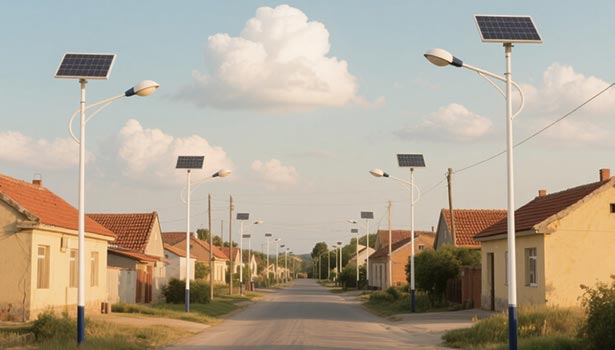
Housing
Rural areas often experience heavy rainfall, high humidity, dust, and significant day-night temperature fluctuations. Therefore, the street light housing must be sufficiently durable to withstand these challenging environmental conditions. Die-cast aluminum is the preferred material: it is lightweight, reducing the load on the lamp post during installation; it has excellent heat dissipation properties, allowing heat generated during operation to be quickly dissipated, preventing overheating from affecting the lifespan of internal components; and it has strong sealing properties, effectively preventing rainwater and dust from entering.
Avoid iron housings, as iron housings are prone to rusting in the humid rural environment. Rust can gradually corrode the housing, potentially affecting internal circuits, significantly shortening the lifespan of the street light, and increasing the frequency of repairs and replacements.
Battery
The battery is responsible for storing electrical energy for use during nighttime and inclement weather, and its reliability directly impacts the stable operation of street lights. Phosphate iron lithium batteries are now being widely promoted in rural areas for a simple reason: they are less prone to leakage or swelling in the humid and high-temperature environments of rural areas, offering significantly higher safety than traditional batteries; they can withstand over 2,000 charge-discharge cycles, greatly reducing replacement frequency and eliminating the hassle of frequent purchases; even in the freezing winters of northern rural areas, they maintain over 70% discharge efficiency and do not “shut down” due to low temperatures. . When selecting batteries, ensure the capacity meets daily lighting needs while reserving sufficient backup for cloudy days. Additionally, prioritize reputable brands to avoid frequent repairs due to quality issues, which could disrupt villagers' nighttime mobility.
Solar Panels
Solar panels convert sunlight into electricity, with conversion efficiency being the key factor. Monocrystalline silicon solar panels are an excellent choice—they convert more sunlight into electricity, making them practical for rural areas with limited installation space. When selecting solar panels, consider the local sunlight conditions: if the village has moderate daily sunlight, choose a panel of appropriate size and reserve some extra capacity to cope with cloudy days, ensuring stable operation of the street lights.
Benefits of Solar Street Lights in Villages
Environmental Benefits
Solar street lights do not produce carbon dioxide during operation, avoiding exhaust emissions from diesel generators and smoke pollution from kerosene lamps, thereby protecting the fresh air in rural areas; Traditional street lights require digging up roads to lay cables, which may damage farmland and rural roads, while solar street lights require no cables and cause zero damage to the ground surface; additionally, the LED lights used have a lifespan 5-10 times longer than traditional bulbs, reducing waste from discarded lighting fixtures and aligning with the rural “green development” philosophy.
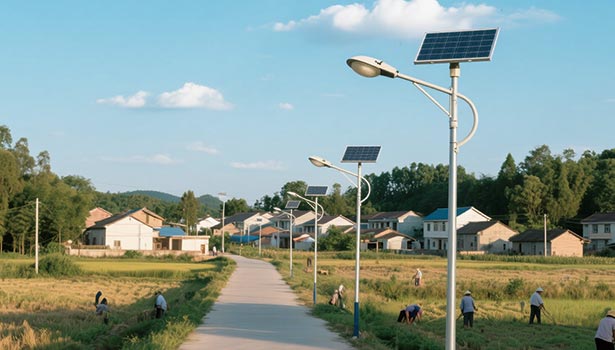
Economic Benefits
Although the initial investment for solar street lights is higher than that for traditional street lights, there are no electricity costs (rural electricity rates may be higher), and maintenance frequency is low (LED lights, batteries, and other components have a long lifespan). Over a 10-year cycle, the total cost of solar street lights is typically 40% lower than that of traditional street lights. Additionally, with stable lighting, rural convenience stores and agricultural product stalls can extend their operating hours, and villagers can perform nighttime activities such as harvesting and processing, thereby increasing income.
Social Benefits
Rural roads are often dirt roads or narrow paths, and without street lights, accidents such as falls and collisions are more likely to occur. Solar street lights illuminate the road surface, making nighttime travel safer for villagers; With lighting, village committee squares can host activities like square dancing and movie screenings, and schools can organize nighttime study sessions and science lectures, enriching villagers' spiritual lives; Stable nighttime lighting is a basic urban infrastructure, and solar street lights enable rural areas to enjoy the same living conditions, enhancing villagers' sense of well-being.
Village-level solar street lights use solar energy as their power source, eliminating dependence on the power grid and fossil fuels, which aligns perfectly with rural needs. They not only reduce long-term costs and environmental impact but also ensure safe travel through stable lighting and expand nighttime activity options, supporting rural development. This clean and convenient lighting solution is becoming an effective choice for improving rural living conditions. As its use expands, it will continue to bring tangible benefits to rural areas, making rural nights safer and more vibrant.


